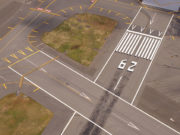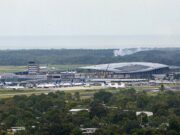
Image: Jacob Boomsma/shutterstock
This article is the 11th in a series on landmark events in aviation since Flight Safety Foundation was founded in 1945.
Throughout aviation history, runway accidents — collisions, incursions, excursions, and wrong-runway takeoffs and landings — have been among the most constant threats to safety.
Runway excursions are among the most frequent accident types (in 2024, second only to turbulence encounters), and runway incursions are among the most fatal. One runway accident — the 1977 collision of two Boeing 747s on the runway at Tenerife-Los Rodeos International Airport in Spain’s Canary Islands, which killed a total of 583 people in the two airplanes — remains the single most deadly aviation accident in history.
Recurring runway accidents have prompted multiple safety campaigns, many of them led by Flight Safety Foundation during its 80-year history.
Dirt and Grass
In the years immediately after the Wright Brothers’ flight, there were no runways. The earliest pilots sought open fields for their landings. Later, dirt or grass strips were created, typically designed to accommodate takeoffs and landings in the direction of the prevailing winds.
What was believed to have been the world’s first paved runway opened in 1916 in Clermont-Ferrand, France, where tire manufacturer Michelin — at the time, also a manufacturer of airplanes — had a factory.
Several years later, in 1919, Orville Wright described a wished-for safety improvement. “[T]o make flying perfectly safe, good landing places must be provided every ten to twelve miles,” he wrote, adding that those landing places would need to be “distinctly marked and carefully prepared” on “reasonably flat ground.”
During the years and decades that followed, Wright’s vision turned to reality, as paved runways became increasingly common.
‘Too High and Too Fast’
Because runways as we know them today were only slowly being built, and because record-keeping in the early days was poor, the first runway excursion accident in Flight Safety Foundation’s Aviation Safety Network (ASN) database that involved a commercial passenger airliner, occurred Dec. 30, 1945, the same year the Foundation was established. The crew of Eastern Airlines Flight 14, a Douglas DC-3, was unable to stop the airplane on the runway at New York’s LaGuardia Airport; the airplane crashed through a localizer structure at the end of the runway and stopped in the waters of Flushing Bay. One of the 14 occupants was killed, and the airplane was destroyed in the crash, which the U.S. Civil Aeronautics Board said resulted from “the decision of the pilot in attempting a landing from an approach which was too high and too fast.”
The earliest runway incursion accident in the ASN database was a March 8, 1947, accident in which a Panair do Brasil DC-3 landing at Rio de Janeiro-Santos Dumont Airport struck a Focke-Wulf Fw200 Condor on the runway. There were no fatalities, and the DC-3 was repaired and returned to flight; the Fw200 was damaged beyond repair.
After that crash, 10 years passed before the next recorded runway incursion accident on Sept. 1, 1957, when an Airwork Handley Page HP.81 Hermes landing at Calcutta-Dum Dum Airport struck an Indian Airlines Douglas C-47A cargo plane that had just been cleared to line up and hold on the same runway. Four crewmembers on the C-47A were killed, all 64 people in the Hermes survived, and both airplanes were destroyed.
The March 27, 1977, runway collision in Tenerife resulted from a runway incursion involving a KLM Boeing 747-200 that had begun a takeoff in low visibility without receiving a takeoff clearance and a Pan American Airways 747 backtracking on the same runway. Spanish accident investigators said the primary cause was the KLM captain’s decision to take off — a decision based on the erroneous belief that air traffic control had issued a takeoff clearance.
Safety Initiatives
Over the years, the aviation community has offered a multitude of runway safety initiatives in various forms.
Among them is the Foundation’s Approach and Landing Accident Reduction Toolkit — a combination of briefing notes, videos, presentations, risk-awareness checklists, and other related products issued in 1998 — which contained data showing that, on average, 17 approach and landing accidents (ALAs) involving airplanes weighing at least 12,500 lb/5,700 kg were recorded worldwide each year from 1980 through 1998. Ten years after the toolkit’s release, data for 2008 showed the number had been reduced to eight ALAs.
In 2006, several international aviation organizations called on the Foundation to coordinate the worldwide Runway Safety Initiative (RSI), with all industry stakeholders represented among study participants. Because data for 1995–2008 that showed commercial aircraft experienced an average of 30 runway excursion accidents each year, that 30 percent of the total 1,429 accidents were runway-related, and that of those, 97 percent were runway excursions, participants focused their efforts on excursions, along with the safety efforts in place at the time.
The final RSI report, issued in 2009, called for “increased planning and vigilance” by flight crews and airport operations staff and recommended, among other things, that they “consider flying the full instrument approach at unfamiliar airports and during darkness instead of electing to conduct a visual approach to expedite arrival.”
In 2011, the Foundation launched its Go-Around Decision-Making and Execution Project, intended not only to determine why established go-around policies were often ignored but also to improve understanding of the risks associated with go-arounds, to mitigate those risks, and to recommend methods of improving compliance.
Two years later, the Foundation said that the project’s analysis of 16 years of aircraft accident data found that “the almost complete failure to call go-arounds as a preventive mitigation of the risk of continuing to fly approaches that are unstable constitutes the number one cause of runway excursions, and therefore of approach and landing accidents.”
In 2020, Flight Safety Foundation and Eurocontrol released the Global Action Plan for the Prevention of Runway Excursions (GAPPRE), a collection of safety recommendations, explanatory material, and guidance aimed at further reducing the rate and number of runway excursions worldwide. Data included in GAPPRE materials showed that between 2005 and mid-2019, 23 percent of the 283 accidents in the International Air Transport Association database involved runway excursions.
The GAPPRE report was followed in 2024 by the Global Action Plan for the Prevention of Runway Incursions (GAPPRI), which followed a format resembling that of its predecessor, including 127 safety recommendations, explanatory material, and guidance aimed at preventing runway excursions. The GAPPRI report warned of the severe potential consequences of a runway incursion and coupled that warning with a caution that the number of incursions is likely to increase as air traffic operations increase.
Data contained in the GAPPRI report showed that although general aviation aircraft are involved in up to 70 percent of runway incursions in some parts of the world, upward trends are seen “not only in the overall rate of high-risk runway incursions but also in airliner involvement in those incidents.”
In the United States alone, of 1,758 incursions reported in fiscal 2024, which ended Sept. 30, 2024, the Federal Aviation Administration (FAA) assigned only nine to Categories A and B (the designations for the most serious incursions — those that, according to ICAO’s definition, had the potential to end in a collision). The remaining incursions were classified as less serious encounters..
The complex combination of factors involved in runway incursions today include the absence of a universally implemented last line of defense against runway collisions and a need for better situational awareness technologies to help controllers detect potential conflicts on runways and other airport surfaces, the GAPPRI report said. The document noted that an apparent breakdown in communications between controllers and pilots — sometimes in the form of simultaneous clearances to aircraft on the same runway — also is a recurrent theme in runway incursions.
The Foundation released a follow-up document, the Runway Incursion Risk and Resilience Assessment (RIRRA), in August 2025, providing a collection of tools for predictive, proactive, and reactive runway incursion risk assessment.
Persistent Accident Types
Despite the industry’s efforts, runway accidents and incidents persist, and the International Civil Aviation Organization (ICAO) considers both runway excursions and runway incursions among the five highest-risk occurrence categories. ICAO Global Action Safety Plan.
In its 2024 Safety Report, published in February 2025, Flight Safety Foundation reported 20 runway excursion accidents in 2024, including two fatal accidents with a total of four fatalities. Those two fatal accidents involved a Fokker 50 cargo flight carrying humanitarian aid for the U.N. World Food Programme that overran a runway in Somalia, killing one pilot; and a de Havilland Canada DHC-5A that veered off a runway in South Sudan, killing three people on the ground. In the five-year period from 2019 through 2023, runway excursion accidents averaged 15.2 per year.
The Safety Report described as “deeply concerning” a number of incidents, “particularly those involving runway incursions,” and noted that common threads have been breakdowns in communications and a lack of situational awareness.
A cluster of runway incursions in the United States in early 2023 included incidents at New York’s Kennedy International Airport and at Austin-Bergstrom International Airport in Texas
The Jan. 13 incursion in New York occurred when an American Airlines 777 crossed Runway 4L without clearance, causing the crew of a Delta Air Lines 737 to halt their takeoff roll on the same runway. The NTSB concluded that the American crew had been distracted by performing other tasks while taxiing, which led to a loss of situational awareness.
The Feb. 4 incursion in Austin occurred when the local controller cleared a Southwest Airlines Boeing 737 to take off on Runway 18 and cleared a FedEx 767 to continue its approach to the same runway. When the FedEx crew saw the Southwest 737 at the approach end of the runway preparing for takeoff, they began a missed approach. At their closest point, the two airplanes were 150 to 170 ft apart, according to the U.S. National Transportation Safety Board (NTSB).
“One missed warning, one incorrect response, even one missed opportunity to strengthen safety can lead to tragedy and destroy public confidence in our aviation system, which is precisely why we must learn from near misses such as these,” NTSB Chair Jennifer Homendy said when the board released its final report on the Texas incident. She said the NTSB was calling on the FAA to order technological intervention to prevent runway incursions “because we must back up the humans operating in our aviation system at every level. That is how we save lives.”


